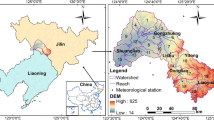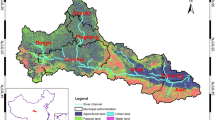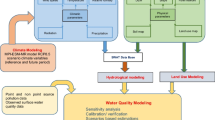Abstract
It is increasingly recognized that climate change could impose both direct and indirect impacts on the quality of the water environment. Previous studies have mostly concentrated on evaluating the impacts of climate change on non-point source pollution in agricultural watersheds. Few studies have assessed the impacts of climate change on the water quality of river basins with complex point and non-point pollution sources. In view of the gap, this paper aims to establish a framework for stochastic assessment of the sensitivity of water quality to future climate change in a river basin with complex pollution sources. A sub-daily soil and water assessment tool (SWAT) model was developed to simulate the discharge, transport, and transformation of nitrogen from multiple point and non-point pollution sources in the upper Huai River basin of China. A weather generator was used to produce 50 years of synthetic daily weather data series for all 25 combinations of precipitation (changes by − 10, 0, 10, 20, and 30%) and temperature change (increases by 0, 1, 2, 3, and 4 °C) scenarios. The generated daily rainfall series was disaggregated into the hourly scale and then used to drive the sub-daily SWAT model to simulate the nitrogen cycle under different climate change scenarios. Our results in the study region have indicated that (1) both total nitrogen (TN) loads and concentrations are insensitive to temperature change; (2) TN loads are highly sensitive to precipitation change, while TN concentrations are moderately sensitive; (3) the impacts of climate change on TN concentrations are more spatiotemporally variable than its impacts on TN loads; and (4) wide distributions of TN loads and TN concentrations under individual climate change scenario illustrate the important role of climatic variability in affecting water quality conditions. In summary, the large variability in SWAT simulation results within and between each climate change scenario highlights the uncertainty of the impacts of climate change and the need to incorporate extreme conditions in managing water environment and developing climate change adaptation and mitigation strategies.











Similar content being viewed by others
References
Chattaraj S, Chakraborty D, Sehgal VK, Paul RK, Singh SD, Daripa A, Pathak H (2014) Predicting the impact of climate change on water requirement of wheat in the semi-arid Indo-Gangetic Plains of India. Agric Ecosyst Environ 197:174–183
Chen J, Brissette FP (2014) Comparison of five stochastic weather generators in simulating daily precipitation and temperature for the Loess Plateau of China. Int J Climatol 34:3089–3105
Dessu SB, Melesse AM (2013) Impact and uncertainties of climate change on the hydrology of the Mara River basin, Kenya/Tanzania. Hydrol Process 27:2973–2986
Detrembleur S, Stilmant F, Dewals B, Erpicum S, Archambeau P, Pirotton M (2015) Impacts of climate change on future flood damage on the river Meuse, with a distributed uncertainty analysis. Nat Hazards 77:1533–1549
Dunn SM, Brown I, Sample J, Post H (2012) Relationships between climate, water resources, land use and diffuse pollution and the significance of uncertainty in climate change. J Hydrol 434:19–35
El-Khoury A, Seidou O, Lapen DR, Que Z, Mohammadian M, Sunohara M, Bahram D (2015) Combined impacts of future climate and land use changes on discharge, nitrogen and phosphorus loads for a Canadian river basin. J Environ Manag 151:76–86
Fatichi S, Ivanov VY, Caporali E (2011) Simulation of future climate scenarios with a weather generator. Adv Water Resour 34:448–467
Gassman P, Reyes M, Green C, Arnold J (2007) The soil and water assessment tool: historical development, applications, and future research directions. Trans ASABE 50:1211–1250
Gassman PW, Sadeghi AM, Srinivasan R (2014) Applications of the SWAT model special section: overview and insights. J Environ Qual 43:1–8
Geng R, Zhang P, Pang S, Wang X, Ma W (2015) Impacts of different climate change scenarios on non-point source polluiton loads in Minyun Reservoir watershed. Trans Chinese Soc Agr Eng 31:240–249 (in Chinese)
Glavan M, Ceglar A, Pintar M (2015) Assessing the impacts of climate change on water quantity and quality modelling in small Slovenian Mediterranean catchment—lesson for policy and decision makers. Hydrol Process 29:3124–3144
Gupta SC, Kessler AC, Brown MK, Zvomuya F (2015) Climate and agricultural land use change impacts on streamflow in the upper midwestern United States. Water Resour Res 51:5301–5317
Hay LE, Wilby RJL, Leavesley GH (2000) A comparison of delta change and downscaled GCM scenarios for three mountainous basins in the United States. J Am Water Resour Assoc 36(2):387–397
Hrdinka T, Novicky O, Hanslik E, Rieder M (2012) Possible impacts of floods and droughts on water quality. J Hydro Environ Res 6:145–150
Huttunen I, Lehtonen H, Huttunen M, Piirainen V, Korppoo M, Veijalainen N, Viitasalo M, Vehvilainen B (2015) Effects of climate change and agricultural adaptation on nutrient loading from Finnish catchments to the Baltic Sea. Sci Total Environ 529:168–181
IPCC (2013) Climate change 2013: The physical science basis. In: Stocker TF, Qin D, Plattner G-K, Tignor M, Allen SK, Boschung J, Nauels A, Xia Y, Bex V, Midgley PM (eds) Contribution of working group I to the fifth assessment report of the Intergovernmental Panel on Climate Change. Cambridge University Press, Cambridge, p 1535
IPCC (2014) Climate change 2014: Impacts, adaptation, and vulnerability part A: Global and sectoral aspects. In: Field CB, Barros VR, Dokken DJ, Mach KJ, Mastrandrea MD, Bilir TE, Chatterjee M, Ebi KL, Estrada YO, Genova RC, Girma B, Kissel ES, Levy AN, MacCracken S, Mastrandrea PR, and White LL (eds) Contribution of working group II to the fifth assessment report of the Intergovernmental Panel on Climate Change. Cambridge University Press, Cambridge, pp 1132
Jha MK, Gassman PW (2014) Changes in hydrology and streamflow as predicted by a modelling experiment forced with climate models. Hydrol Process 28:2772–2781
Jisun C, Soyoung P, Yeon Y, Hong-Joo Y, Chuluong C, Jinsoo K (2013) Impacts of climate change under IPCC RCP scenarios on streamflow and water quality in the Youngsan Basin, South Korea. Disaster Adv 6:134–141
Johnson T, Butcher J, Deb D, Faizullabhoy M, Hummel P, Kittle J, McGinnis S, Mearns LO, Nover D, Parker A, Sarkar S, Srinivasan R, Tuppad P, Warren M, Weaver C, Witt J (2015) Modeling streamflow and water quality sensitivity to climate change and urban development in 20 US watersheds. J Am Water Resour Assoc 51:1321–1341
Kharel G, Kirilenko A (2015) Considering climate change in the estimation of long-term flood risks of Devils Lake in North Dakota. J Am Water Resour Assoc 51:1221–1234
Lu GH, Xiao H, Wu ZY, Zhang SL, Li Y (2013) Assessing the impacts of future climate change on hydrology in Huang-Huai-Hai Region in China using the PRECIS and VIC Models. J Hydrol Eng 18:1077–1087
Ma C, Pan SL, Wang GQ, Liao YF, Xu YP (2016) Changes in precipitation and temperature in Xiangjiang River Basin, China. Theor Appl Climatol 123:859–871
Mendoza-Resendiz A, Arganis-Juarez M, Dominguez-Mora R, Echavarria B (2013) Method for generating spatial and temporal synthetic hourly rainfall in the Valley of Mexico. Atm Res 132-133:411–422
Molina-Navarro E, Trolle D, Martinez-Perez S, Sastre-Merlin A, Jeppesen E (2014) Hydrological and water quality impact assessment of a Mediterranean limno-reservoir under climate change and land use management scenarios. J Hydrol 509:354–366
Nepal S (2016) Impacts of climate change on the hydrological regime of the Koshi river basin in the Himalayan region. J Hydro Environ Res 10:76–89
Nkomozepi T, Chung SO (2014) The effects of climate change on the water resources of the Geumho River Basin, Republic of Korea. J Hydro Environ Res 8:358–366
Peterson TC, Karl TR, Kossin JP, Kunkel KE, Lawrimore JH, McMahon JR, Vose RS, Yin XG (2014) Changes in weather and climate extremes: state of knowledge relevant to air and water quality in the United States. J Air Waste Manage Assoc 64:184–197
Prudhomme C, Wilby RL, Crooks S, Kay AL, Reynard NS (2010) Scenario-neutral approach to climate change impact studies: application to flood risk. J Hydrol 390:198–209
Prudhomme C, Crooks S, Kay AL, Reynard N (2013) Climate change and river flooding: part 1 classifying the sensitivity of British catchments. Clim Chang 119:933–948
Puig A, Salinas HFO, Borus JA (2016) Relevance of the Parana River hydrology on the fluvial water quality of the Delta Biosphere Reserve. Environ Sci Pollu Res 23:11430–11447
Rankinen K, Gao G, Granlund K, Gronroos J, Vesikko L (2015) Comparison of impacts of human activities and climate change on water quantity and quality in Finnish agricultural catchments. Landsc Ecol 30:415–428
Ravazzani G, Barbero S, Salandin A, Senatore A, Mancini M (2015) An integrated hydrological model for assessing climate change impacts on water resources of the Upper Po River Basin. Water Resour Manag 29:1–23
Semenov MA (2008) Simulation of extreme weather events by a stochastic weather generator. Clim Res 35:203–212
Semenov MA, Barrow EM (1997) Use of a stochastic weather generator in the development of climate change scenarios. Clim Chang 35:397–414
Semenov MA, Brooks RJ, Barrow EM, Richardson CW (1998) Comparison of the WGEN and LARS-WG stochastic weather generators for diverse climates. Clim Res 10:95–107
Thomas D, Johannes K, David K, Rudiger G, Ralf K (2016) Impacts of management and climate change on nitrate leaching in a forested karst area. J Environ Manag 165:243–252
Trang NTT, Shrestha S, Shrestha M, Datta A, Kawasaki A (2017) Evaluating the impacts of climate and land-use change on the hydrology and nutrient yield in a transboundary river basin: a case study in the 3S River Basin (Sekong, Sesan, and Srepok). Sci Total Environ 576:586–598
Vanuytrecht E, Raes D, Willems P, Semenov MA (2014) Comparing climate change impacts on cereals based on CMIP3 and EU-ENSEMBLES climate scenarios. Agric For Meteorol 195:12–23
Verma S, Bhattarai R, Bosch NS, Cooke RC, Kalita PK, Markus M (2015) Climate change impacts on flow, sediment and nutrient export in a Great Lakes watershed using SWAT. Clean-Soil Air Water 43:1464–1474
Viola MR, de Mello CR, Chou SC, Yanagi SN, Gomes JL (2015) Assessing climate change impacts on Upper Grande River Basin hydrology, Southeast Brazil. Int J Climatol 35:1054–1068
Wang GQ, Zhang JY (2015) Variation of water resources in the Huang-huai-hai areas and adaptive strategies to climate change. Quat Int 380:180–186
Wang GQ, Zhang JY, Liu JF, Jin JL, Liu CS (2011) The sensitivity of runoff to climate change in different climatic regions in China. Adv Water Sci 22(3):307–314 (in Chinese)
Wu L, Long TY, Liu X, Guo JS (2012) Impacts of climate and land-use changes on the migration of non-point source nitrogen and phosphorus during rainfall-runoff in the Jialing River Watershed, China. J Hydrol 475:26–41
Xia XH, Wu Q, Mou XL, Lai YJ (2015) Potential impacts of climate change on the water quality of different water bodies. J Environ Inform 25:85–98
Xu H (2016) Response of river discharge and output of nitrogen and phosphorous to precipitation in the upstream Dongjiang River. Pearl River 37:43–47 (in Chinese)
Yang X, Liu Q, Fu G, He Y, Luo X, Zheng Z (2016a) Spatiotemporal patterns and source attribution of nitrogen load in a river basin with complex pollution sources. Water Res 94:187–199
Yang X, Liu Q, He Y, Luo X, Zhang X (2016b) Comparison of daily and sub-daily swat models for daily streamflow simulation in the Upper Huai River Basin of China. Stoch Environ Res Risk Assess 30:959–972
Yao YL, Wang L, Lu XG, Yu HX (2012) Assessing the sensitivity of runoff to climate change in Naoli River watershed, Northeast China. Geogr Res 31(3):409–416 (in Chinese)
Zhang Y, Xia J, Shao Q, Zhai X (2013) Water quantity and quality simulation by improved SWAT in highly regulated Huai River Basin of China. Stoch Environ Res Risk Assess 27:11–27
Zhang C, Lai SY, Gao XP, Xu LP (2015) Potential impacts of climate change on water quality in a shallow reservoir in China. Environ Sci Pollut Res 22:18372–18380
Zhao FZ, Zhang CH, Hao LQ (2008) Transboundary flow change of the Lancang River. J Yunnan Univ (Nat Sci Ed) 30:329–333 (in Chinese)
Funding
This work was supported by the Open Foundation of State Key Laboratory of Hydrology-Water Resources and Hydraulic Engineering (2016490411), National Key Research and Development Program of China (2016YFA0601501), Chinese Natural Science Foundation (41201191), and Chinese National Engineering Laboratory for Circular Economy.
Author information
Authors and Affiliations
Corresponding authors
Additional information
Responsible editor: Boqiang Qin
Rights and permissions
About this article
Cite this article
Yang, X., Tan, L., He, R. et al. Stochastic sensitivity analysis of nitrogen pollution to climate change in a river basin with complex pollution sources. Environ Sci Pollut Res 24, 26545–26561 (2017). https://doi.org/10.1007/s11356-017-0257-y
Received:
Accepted:
Published:
Issue Date:
DOI: https://doi.org/10.1007/s11356-017-0257-y




